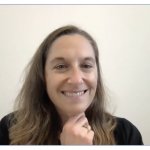Climbing the Tower: Developing Your First Promotion Packet as an Academic Collaborative Statistician
Christina Mehta, Emily Leary, Charlotte Bolch, Xiaoming Sheng, and Margaret Stedman

Walter Ambrosius is professor and chair of the department of biostatistics and data science at Wake Forest School of Medicine.

Leslie McClure is professor and chair of the department of epidemiology and biostatistics and associate dean for faculty affairs in the Dornsife School of Public Health at Drexel University.
In October of 2021, the ASA Pathways to Promotion Committee brought together Walter Ambrosius and Leslie McClure for a webinar in their Establishing a Collaborative Career in Academia series. The topic of the free webinar, which drew more than 105 attendees, was “Developing Your Promotion Packet as an Academic Collaborative Statistician.”
Challenges
Feedback from the first webinar in the series, “Advice for the Promotion of Collaborative Statisticians in Research and Teaching Institutions,” inspired the current topic and helped identify the following three main challenges the junior academic collaborative statistician has when preparing and being considered for promotion:
- A lack of mentorship and strategic planning toward promotion
- Competing demands on time
- A poor perception/misunderstanding of the role of collaborative statisticians in academia
These challenges stem from the traditional approach of many academic departments in which collaborative team research is limited. It is often difficult for an academic collaborative statistician to clearly showcase their individual contribution to a project. More specifically, junior academic collaborative statisticians reported challenges in classifying their contributions, including collaborative research and multidisciplinary teaching, as they do not easily fall into the standard teaching, research, and service evaluation categories.
In addition, planning for promotion is complicated by a lack of universal consensus on evaluation criteria for team scientists, combined with fewer senior collaborative statistics faculty to provide advice and mentorship.
This is further exacerbated by the perception that collaborative statisticians are simply technicians, versus experts who can identify opportunities to improve research through innovation and application of new techniques.
Many comments indicated difficulty in adjusting effort levels, such as increasing teaching or independent research contributions, while balancing strong demand from collaborative partnerships. A related concern was for the isolated statistician without a clear path and in a unique role as the first or only collaborative statistician in an academic department.
Advice
Ambrosius and McClure advised the audience to learn the detailed promotion process within their home institutions, understand what is valued at the departmental and institutional levels, and consider the politics and priorities of the promotion and tenure committee. They also emphasized the importance of pursuing all opportunities to learn more about the promotion process, including annual workshops; informal promotion reviews; and resources and advice from mentors, department chairs/heads, and other colleagues who have been successfully promoted.
Most importantly, they urged the audience to recognize they are their own best advocate. Ambrosius and McClure told audience members to highlight their accomplishments and “sell” themselves—being explicit and not humble—so their contributions are understood and contextualized for all who may review their promotion packets. This includes understanding their strengths and weaknesses so strengths can be highlighted and weaknesses can be addressed.
Both Ambrosius and McClure also discussed letters of evaluation from external reviewers. They recommended using service opportunities such as grant review panels, professional committees, and conference panels to identify potential letter writers. When choosing reviewers to provide external letters of evaluation, they suggested selecting reviewers who, collectively, can assess all aspects of a promotion packet because it is unlikely to find writers with matching expertise.
In addition, if allowed by the institution, they suggest contacting potential reviewers ahead of time to gauge their willingness and ability to provide an evaluation and (also if allowed) suggest topics to the reviewers. They also encouraged audience members to ensure their packets are well organized and easy for reviewers to navigate and to include thoughtful, well-written, personal narrative statements.
Last, the panelists acknowledged the importance of having a supportive chair and institution when it comes to promoting collaborative statisticians.
Watch the Discussion
If you missed the opportunity to participate in this webinar, the Section on Statistical Consulting has posted the recording of it and others on their YouTube channel. Like and subscribe to the channel to be notified about future webinars.

















